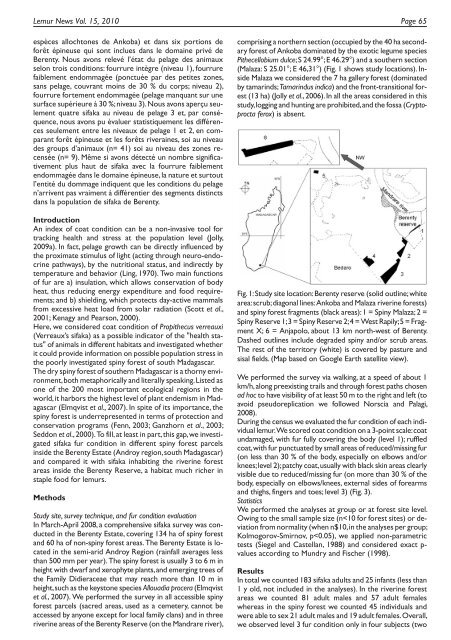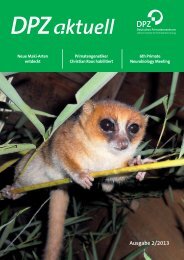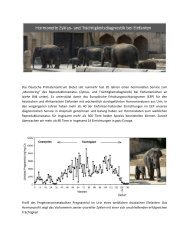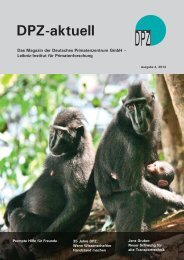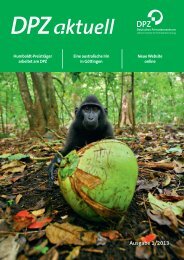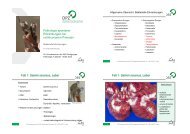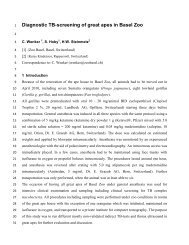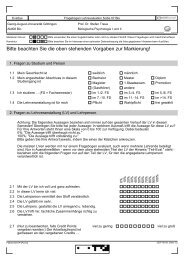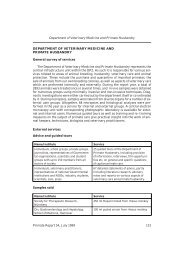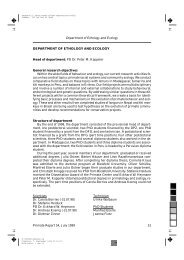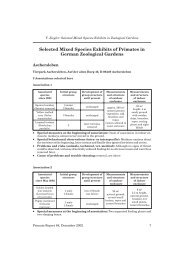Vol. 15 - Deutsches Primatenzentrum
Vol. 15 - Deutsches Primatenzentrum
Vol. 15 - Deutsches Primatenzentrum
You also want an ePaper? Increase the reach of your titles
YUMPU automatically turns print PDFs into web optimized ePapers that Google loves.
Lemur News <strong>Vol</strong>. <strong>15</strong>, 2010 Page 65<br />
espèces allochtones de Ankoba) et dans six portions de<br />
forêt épineuse qui sont inclues dans le domaine privé de<br />
Berenty. Nous avons relevé l’état du pelage des animaux<br />
selon trois conditions: fourrure intègre (niveau 1), fourrure<br />
faiblement endommagée (ponctuée par des petites zones,<br />
sans pelage, couvrant moins de 30 % du corps; niveau 2),<br />
fourrure fortement endommagée (pelage manquant sur une<br />
surface supérieure à 30 %;niveau 3).Nous avons aperçu seulement<br />
quatre sifaka au niveau de pelage 3 et, par conséquence,<br />
nous avons pu évaluer statistiquement les différences<br />
seulement entre les niveaux de pelage 1 et 2, en comparant<br />
forêt épineuse et les forêts riveraines, soi au niveau<br />
des groups d’animaux (n= 41) soi au niveau des zones recensée<br />
(n= 9). Même si avons détecté un nombre significativement<br />
plus haut de sifaka avec la fourrure faiblement<br />
endommagée dans le domaine épineuse,la nature et surtout<br />
l’entité du dommage indiquent que les conditions du pelage<br />
n’arrivent pas vraiment à différentier des segments distincts<br />
dans la population de sifaka de Berenty.<br />
Introduction<br />
An index of coat condition can be a non-invasive tool for<br />
tracking health and stress at the population level (Jolly,<br />
2009a). In fact, pelage growth can be directly influenced by<br />
the proximate stimulus of light (acting through neuro-endocrine<br />
pathways), by the nutritional status, and indirectly by<br />
temperature and behavior (Ling, 1970). Two main functions<br />
of fur are a) insulation, which allows conservation of body<br />
heat, thus reducing energy expenditure and food requirements;<br />
and b) shielding, which protects day-active mammals<br />
from excessive heat load from solar radiation (Scott et al.,<br />
2001; Kenagy and Pearson, 2000).<br />
Here, we considered coat condition of Propithecus verreauxi<br />
(Verreaux’s sifaka) as a possible indicator of the "health status"<br />
of animals in different habitats and investigated whether<br />
it could provide information on possible population stress in<br />
the poorly investigated spiny forest of south Madagascar.<br />
The dry spiny forest of southern Madagascar is a thorny environment,both<br />
metaphorically and literally speaking.Listed as<br />
one of the 200 most important ecological regions in the<br />
world,it harbors the highest level of plant endemism in Madagascar<br />
(Elmqvist et al., 2007). In spite of its importance, the<br />
spiny forest is underrepresented in terms of protection and<br />
conservation programs (Fenn, 2003; Ganzhorn et al., 2003;<br />
Seddon et al.,2000).To fill,at least in part,this gap,we investigated<br />
sifaka fur condition in different spiny forest parcels<br />
inside the Berenty Estate (Androy region,south Madagascar)<br />
and compared it with sifaka inhabiting the riverine forest<br />
areas inside the Berenty Reserve, a habitat much richer in<br />
staple food for lemurs.<br />
Methods<br />
Study site, survey technique, and fur condition evaluation<br />
In March-April 2008, a comprehensive sifaka survey was conducted<br />
in the Berenty Estate, covering 134 ha of spiny forest<br />
and 60 ha of non-spiny forest areas. The Berenty Estate is located<br />
in the semi-arid Androy Region (rainfall averages less<br />
than 500 mm per year). The spiny forest is usually 3 to 6 m in<br />
height with dwarf and xerophyte plants,and emerging trees of<br />
the Family Didieraceae that may reach more than 10 m in<br />
height,such as the keystone species Allouadia procera (Elmqvist<br />
et al., 2007). We performed the survey in all accessible spiny<br />
forest parcels (sacred areas, used as a cemetery, cannot be<br />
accessed by anyone except for local family clans) and in three<br />
riverine areas of the Berenty Reserve (on the Mandrare river),<br />
comprising a northern section (occupied by the 40 ha secondary<br />
forest of Ankoba dominated by the exotic legume species<br />
Pithecellobium dulce;S 24.99°;E 46.29°) and a southern section<br />
(Malaza: S 25.01°; E 46,31°) (Fig. 1 shows study locations). Inside<br />
Malaza we considered the 7 ha gallery forest (dominated<br />
by tamarinds;Tamarindus indica) and the front-transitional forest<br />
(13 ha) (Jolly et al.,2006).In all the areas considered in this<br />
study,logging and hunting are prohibited,and the fossa (Cryptoprocta<br />
ferox) isabsent.<br />
Fig.1:Study site location:Berenty reserve (solid outline;white<br />
area:scrub;diagonal lines:Ankoba and Malaza riverine forests)<br />
and spiny forest fragments (black areas): 1 = Spiny Malaza; 2 =<br />
Spiny Reserve 1;3 = Spiny Reserve 2;4 = West Rapily;5 = Fragment<br />
X; 6 = Anjapolo, about 13 km north-west of Berenty.<br />
Dashed outlines include degraded spiny and/or scrub areas.<br />
The rest of the territory (white) is covered by pasture and<br />
sisal fields. (Map based on Google Earth satellite view).<br />
We performed the survey via walking, at a speed of about 1<br />
km/h,along preexisting trails and through forest paths chosen<br />
ad hoc to have visibility of at least 50 m to the right and left (to<br />
avoid pseudoreplication we followed Norscia and Palagi,<br />
2008).<br />
During the census we evaluated the fur condition of each individual<br />
lemur.We scored coat condition on a 3-point scale:coat<br />
undamaged, with fur fully covering the body (level 1); ruffled<br />
coat,with fur punctuated by small areas of reduced/missing fur<br />
(on less than 30 % of the body, especially on elbows and/or<br />
knees;level 2);patchy coat,usually with black skin areas clearly<br />
visible due to reduced/missing fur (on more than 30 % of the<br />
body, especially on elbows/knees, external sides of forearms<br />
and thighs, fingers and toes; level 3) (Fig. 3).<br />
Statistics<br />
We performed the analyses at group or at forest site level.<br />
Owing to the small sample size (n


